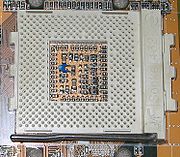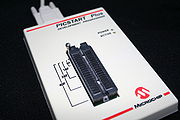
ZIF
Encyclopedia

Electrical connector
An electrical connector is an electro-mechanical device for joining electrical circuits as an interface using a mechanical assembly. The connection may be temporary, as for portable equipment, require a tool for assembly and removal, or serve as a permanent electrical joint between two wires or...
s invented to avoid problems caused by applying force upon insertion and extraction.
A normal integrated circuit
Integrated circuit
An integrated circuit or monolithic integrated circuit is an electronic circuit manufactured by the patterned diffusion of trace elements into the surface of a thin substrate of semiconductor material...
(IC) socket requires the IC to be pushed into sprung contacts which then grip by friction
Friction
Friction is the force resisting the relative motion of solid surfaces, fluid layers, and/or material elements sliding against each other. There are several types of friction:...
. For an IC with hundreds of pins, the total insertion force can be very large (tens of newtons), leading to a danger of damage to the device or the circuit board. Also even with relatively small pin counts each extraction is fairly awkward and carries a significant risk of bending pins (particularly if the person performing the extraction hasn't had much practice or the board is crowded). Low insertion force
Low insertion force
thumb|300px|right|LIF-connector of a 1.8" [[hard disk drive]]Low-insertion-force sockets are integrated circuit sockets that are designed so the force required to insert or remove a package is low....
(LIF) sockets reduce the issues of insertion and extraction but the lower the insertion force of a conventional socket, the less reliable the connection is likely to be.
With a ZIF socket, before the IC is inserted, a lever or slider on the side of the socket is moved, pushing all the sprung contacts apart so that the IC can be inserted with very little force (generally the weight of the IC itself is sufficient with no external downward force required). The lever is then moved back, allowing the contacts to close and grip the pins of the IC. ZIF sockets are much more expensive than standard IC sockets and also tend to take up a larger board area due to the space taken up by the mechanism. Therefore they are only used when there is a good reason to do so.
Large ZIF sockets are only commonly found mounted on PC
Personal computer
A personal computer is any general-purpose computer whose size, capabilities, and original sales price make it useful for individuals, and which is intended to be operated directly by an end-user with no intervening computer operator...
motherboard
Motherboard
In personal computers, a motherboard is the central printed circuit board in many modern computers and holds many of the crucial components of the system, providing connectors for other peripherals. The motherboard is sometimes alternatively known as the mainboard, system board, or, on Apple...
s (from about the mid 1990s forward). These CPU socket
CPU socket
A CPU socket or CPU slot is a mechanical component that provides mechanical and electrical connections between a microprocessor and a printed circuit board . This allows the CPU to be replaced without soldering....
s are designed to support a particular range of CPUs, allowing computer retailers and consumers to assemble motherboard/CPU combinations based on individual budget and requirements. The rest of the electronics industry has largely abandoned sockets and moved to surface mount components soldered directly to the board.
Smaller ZIF sockets are commonly used in chip-testing and programming equipment, e.g. programming and testing on EEPROMs, Microcontrollers, etc.
Universal test sockets

Dual in-line package
In microelectronics, a dual in-line package is an electronic device package with a rectangular housing and two parallel rows of electrical connecting pins. The package may be through-hole mounted to a printed circuit board or inserted in a socket.A DIP is usually referred to as a DIPn, where n is...
come in two widths (measured between pin centers), 0.3 in (7.62 mm) (skinny dip) for smaller devices (8-28 pin) and 0.6 in (15.24 mm) for larger devices (24-40 pin). To allow design of programmers and similar devices that supported a range of devices some in skinny dip and some in full width dip universal test sockets are produced. These have wide slots into which the pins drop allowing both 0.3 in and 0.6 in devices to be inserted.
Ball grid array sockets
ZIF sockets can be used for ball grid arrayBall grid array
A ball grid array is a type of surface-mount packaging used for integrated circuits.- Description :The BGA is descended from the pin grid array , which is a package with one face covered with pins in a grid pattern. These pins conduct electrical signals from the integrated circuit to the printed...
chips, particularly during development. These sockets tend to be unreliable, failing to grab all the balls. Another type of BGA socket, also free of insertion force but not a "ZIF socket" in the traditional sense, does a better job by using spring pins to push up underneath the balls.
ZIF wire-to-board connectors
ZIF wire-to-board connectors are used for attaching wires to printed circuit boardPrinted circuit board
A printed circuit board, or PCB, is used to mechanically support and electrically connect electronic components using conductive pathways, tracks or signal traces etched from copper sheets laminated onto a non-conductive substrate. It is also referred to as printed wiring board or etched wiring...
s inside electronic
Electronics
Electronics is the branch of science, engineering and technology that deals with electrical circuits involving active electrical components such as vacuum tubes, transistors, diodes and integrated circuits, and associated passive interconnection technologies...
equipment. The wires, often formed into a ribbon cable
Ribbon cable
A ribbon cable is a cable with many conducting wires running parallel to each other on the same flat plane. As a result the cable is wide and flat. Its name comes from the resemblance of the cable to a piece of ribbon.Ribbon cables are usually seen for internal peripherals in computers, such as...
, are pre-stripped and the bare ends placed inside the connector. The two sliding parts of the connector are then pushed together, causing it to grip the wires. The most important advantage of this system is that it does not require a mating half to be fitted to the wire ends, therefore saving space and cost inside miniaturised equipment. See flexible flat cable.
Hard disk drives
ZIF tape connections are used for connecting IDE and SATA disk drives (mostly 1.8" factor). ZIF-style connectors for IDE hard drives were used primarily in the design of Ultra-Portable notebooks, and has since been phased out, as SATA has a relatively small-form-factor connector by default. Also, nearly all hard drives use ZIF tape to connect their circuit board to their platter motor.Three types of ZIF connectors are known to exist on 1.8" drives. ZIF-24, ZIF-40, and ZIF-50 with 24, 40, and 50 pins respectively.
ZIF tape connections are also heavily used in the design of the Apple Inc. iPod
IPod
iPod is a line of portable media players created and marketed by Apple Inc. The product line-up currently consists of the hard drive-based iPod Classic, the touchscreen iPod Touch, the compact iPod Nano, and the ultra-compact iPod Shuffle...
range of portable media players.

